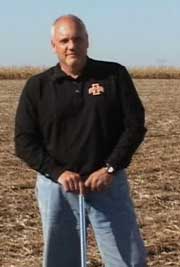Ames, Iowa
December 1, 2008
 Two
videos featuring an Iowa State
University plant pathology professor are featured on the
Corn and Soybean Digest magazine's Web site. Two
videos featuring an Iowa State
University plant pathology professor are featured on the
Corn and Soybean Digest magazine's Web site.
Greg Tylka is an extension plant pathologist and nematologist,
plus coordinator of Iowa State's Corn and Soybean Initiative. In
the videos, he demonstrates how to test for soybean cyst
nematodes (SCN). The most recent video has Tylka showing the
proper way to do soil sampling after harvest in both soybean and
corn fields.
"It will be possible to conduct soil samples for SCN testing for
a few more weeks, until there is persistent snow cover or the
top eight inches of soil are frozen," Tylka said. "Fall is the
ideal time to collect soil samples to determine if SCN eggs are
present. This gives the producer time to make important
management decisions before spring."
Once a soybean field has been planted, the next opportunity to
scout for SCN begins about six weeks after planting and runs
through August. In a video produced earlier this year, Tylka
demonstrated how to dig soybean plants and gently remove soil
from the roots in search of small white "dots" that are female
soybean cyst nematodes.
"Research has shown plants in a soybean field can look perfectly
healthy, yet still be infected by SCN," Tylka said. "That's why
it's important for producers to check for SCN, either during the
growing season or after harvest. Knowing which fields are
infested with SCN is the first step to successfully managing the
nematode. These videos will help producers properly test for
this pest, which is causing serious yield losses across the
Midwest and elsewhere."
Personnel in the ISU College of Agriculture and Life Sciences
produced the videos. The videos are posted on the Corn and
Soybean Digest CSDLive feature on the magazine's Web site at
http://cornandsoybeandigest.com/tv. |
|